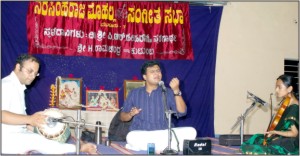Mysore:
In olden days, a student of music had to learn the art by staying in the house of his guru, according to Gurukula system. Thus their academic education took a back seat. But as they become proficient in music, they also would acquire the knowledge of Sanskrit, Kannada, Telugu, Tamil and other languages required for music. They would also become scholars in Philosophy, Veda, Tarka (logic) and such other ancient Shastras in Sanskrit.
There may be some exceptions here also, like Maharaja Jayachamaraja Wadiyar who was a post-graduate in philosophy from Mysore University and an alumni of Trinity College of London, who after graduating in music, balanced music and the responsibility of ruling his land magnificently; or T.V. Shankaranarayana, who was a lawyer, who left the law profession and became a full-fledged musician or the case of vocalist R.K. Pad-manabha, who left a well-paying Bank job and dedicated himself for the cause of music.
If the Maharaja managed both profession and music, the remaining two left the profession for the sake of music. There are a few others who fall in these categories, but they can be counted on fingertips.
It is interesting to note that in our time, many well-educated youth, in particular, are choosing music either as a profession or as a hobby. H.K. Venkata Ram, Manasa Nayana, Manasi Prasad, Pattabhi Rama Pandit, Saketh Raman are only a few names who are highly educated and acquired good status in music. Many even have a Ph.D in music.
Once again as we scan the list, we see the names of Dr. Udaya Kiran and Dr. Hamsini Nagendra (both visually impaired), Dr. Mysore M. Manju-nath, Dr. Sukanya Prabhakar, Dr. R.N. Srilatha, Dr. C.A. Sridhar, Dr. Jayanthi Kumaresh, Dr. S. Geetha, Dr. Meera Rajaram etc. This douses the fear that our culture is being neglected and instills confidence that the future of classical music is safe.
V. Bala Krishna, an Engineering graduate, working in an IT company in Bengaluru, is one among them, who has taken music as a hobby, balancing both the profession and the music. He is a disciple of Delhi Rama Murthy Bhagavatar. He had performed in Mysore once earlier, though it was a short kacheri. In fact I was curious to listen to his full concert. This young lad, bestowed with a rich voice, has tamed it superbly, with good training. His concert had been organised by NR Mohalla San-geetha Sabha on May 19. The accompaniments, violin (Adithi Krishna Prakash) and mrudanga (Sai Shiva Lakshmi Ke-shava) were the same as that of his previous short kacheri at Bidaram Rama Mandira during March, which may be a pure coincidence. In any case, the impressive presentation proved that he is a promising singer.
Bala Krishna set the tone of the concert with a Thodi Varna Eraa Naapai of Patnam Subramanya Iyer, serenely in two speeds. This was embellished with a brief Swara. The next number, a piece on Lord Ganapathi, was the Siddhi Vinayakam Seveham (Mohana Kalyani-Adi-Muthaiah Bhagavatar), which was prefixed with a brief Alapane and a not-so-brief, but leisurely Swara Prasthara.
The subsequent Padmavathi Ramanam (Purvi Kalyani-Mishra Chapu-Ootthukkadu Venkata Kavi) also contained a good Alapane and a Swara Prasthara.
The singer’s control over his voice came to fore in the unhurried rendering of Sujana Jeevana (Khamach-Rupaka-Tyagaraja). He chose Latangi for the Madh-yma Kala Kruti in between two Vilamba Kala Krutis, with Apara-dhamulanni (Latangi-Adi-Patnam Subramanya Iyer), with a Neraval at the Sahitya line Krupajesi Naa Manavyaala, in the same speed.
Mangalampalli Balamurali Krishna has composed a good number of krutis. Though some of them are in popular ragas, the composition of the sahitya and the original sangathis, with which he has composed, pose difficulty to emulate. Bala Krishna chose one such Kruti Kaavave Kanya Kumaari in Shahana. The difficulty comes in inter-mixing the pieces of sahitya in Vilamba and Madhyama Kalas, which this singer successfully executed.
Kalyani was his main melody of the concert. He leisurely went through all the subtle nuances in its delineation. The raga expansion is worth mentioning, as it turned out to be a well-patterned essay in all the three octaves. The use of Akaras, interlacing with Birkas and judiciously using Gamakas was the highlight of the Alapane. He then chose to render the popular number Kamalambaam Bhajare (Vilamba Adi-Muthu Swamy Dikshitar). His lucidity of sahitya is appreciable.
After some interesting san-gathis, he took up a Neraval with the Pallavi line itself Kamalaam-baam Bhajare Re Manasa. Even here, he used the technique of inter-mixing some phrases in Vilamba and Madhyama Kala appealingly. The Swara Prasthara was with superb smoothness and in pleasing progressions, based on pure Manodharma.
The concert concluded with three more numbers, Vanchato-nunaa (Karna Ranjani-Trishra Nade Adi-Muthaiah Bhagavatar), Sada Enna Hrudayadalli (Behag-Rupaka-Vijaya Vittala Dasa) and a Lalgudi Tillana in Brundavani.
The violinist Adithi was a well match for this singer. Both her follow-up and the Tani were superb. Sai Shiva expressed his versatility through his media, mrudanga. The Tani Avartana by him was a clear rhythmic affair.
I may add here that Adithi will be moving to Bengaluru in a few days, as this engineering graduate got a job there.
Mysore will be poorer by one more established violinist. All the best to her.
—S.R. Krishna Murthy
source: http://www.StarofMysore.com / Feature Article / May 30th, 2012
